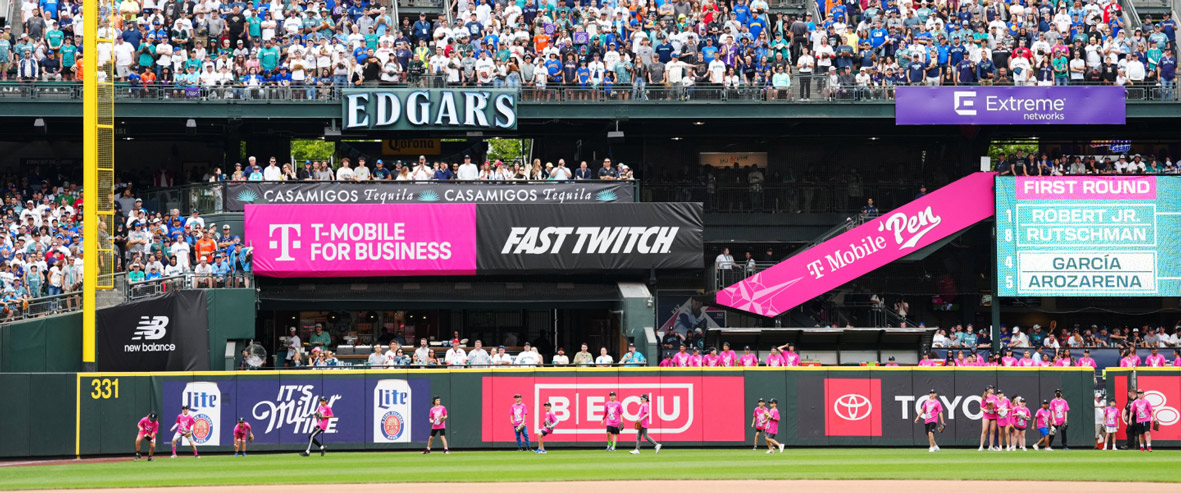
As consumer spending navigates away from tangible goods and into experiences that create indelible memories, sports organizations worldwide are tasked with curating unforgettable experiences for fans. To bring these activations to life, the marriage of technology and sports isn’t just an option — it's a necessity.
The 2023 MLB All-Star Week serves as a prime example.
In its tenth year of partnership with MLB, T-Mobile turned MLB All-Star Week in Seattle into a hotbed of tech innovation for both fans and players.
Powering this spectacle was the T-Mobile 5G network, ensuring a lag-free experience in every seat throughout T-Mobile Park. This robust network architecture, extending from the dugouts to the press box, facilitated the seamless transmission of data, allowing intricate game experiences to come alive.

With a system operating on 5G-connected devices, calls could be challenged by players on the field and then reviewed in real-time using these digital tools.

This was perfectly illustrated by T-Mobile 5G Advanced Network Solutions' critical role in providing secure, ultra-reliable, real-time communications for the test of the Automated Ball-Strike (ABS) Challenge system for MLB at the SiriusXM All-Star Futures Game.
Using ABS, MLB operators observed each pitch’s exact location by leveraging data from multiple sources including cameras stationed throughout the ballpark. With a system operating on 5G-connected devices, calls could be challenged by players on the field and then reviewed in real-time using these digital tools. Decisions were then displayed to teams and spectators alike, courtesy of a 5G private network from T-Mobile.
T-Mobile’s impact was further amplified by the return of the 5G Batting Practice (BP) show during the T-Mobile Home Run Derby, giving fans a special look at heavy-hitters as they warmed up. From HD drone cameras to catchers' masks fitted with cameras, 5G enabled multiple POV real-time feeds, providing fans with unprecedented close-up and bird’s-eye view perspectives of the game.

The event's shining achievement, however, was the introduction of the groundbreaking MLB Next app. Building off the momentum of the Sports Emmy-award-winning augmented reality app MLB and T-Mobile launched in 2021, the new and improved MLB Next app offered fans a one-of-a-kind in-stadium extended reality experience – blending the raw energy of live baseball with the precision of broadcast media.
Designed to turn fans from passive spectators into active participants, the app harnessed the power of augmented reality (AR) to overlay 3D visualizations — player identification, exit velocity, hit distance, and ball trails — onto the live field.

Alongside the visual enhancements, T-Mobile's collaboration with Mixhalo introduced high-quality, low-latency audio from the live game broadcasts directly within the MLB Next app, ensuring fans remained tuned into every exciting play. This innovative approach to fan engagement signals a new era in sports entertainment, blurring the lines between the physical and digital domains.
Off the field, T-Mobile came alive in various interactive installations around the ballpark. The Bat Flip Cage, equipped with 360-degree cameras, generated shareable GIFs of fan bat flips and swings, while the T-Mobile Truck offered free charging stations to ensure fan phones remained juiced up throughout the game.
The modern-day sports fan craves more than the conventional viewing experience. They want to become part of the action, feeling every hit, throw, and catch, whether it be from a stadium seat or the comfort of their couch. With the integration of 5G technology and a gamut of cutting-edge innovations, these two industry titans have managed to do exactly that, giving fans a closer, more immersive connection with the game. It's clear that as America’s past time evolves, T-Mobile and MLB are leading the charge, turning visions of the future into today's reality.











